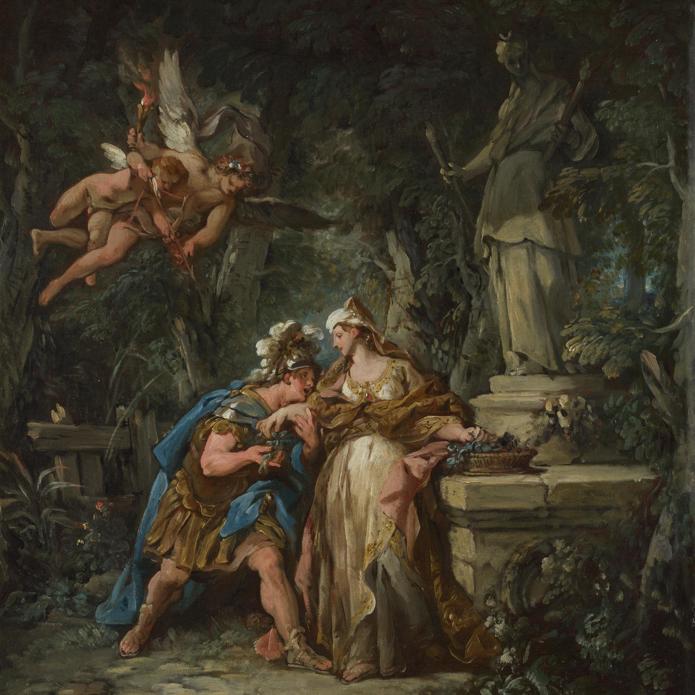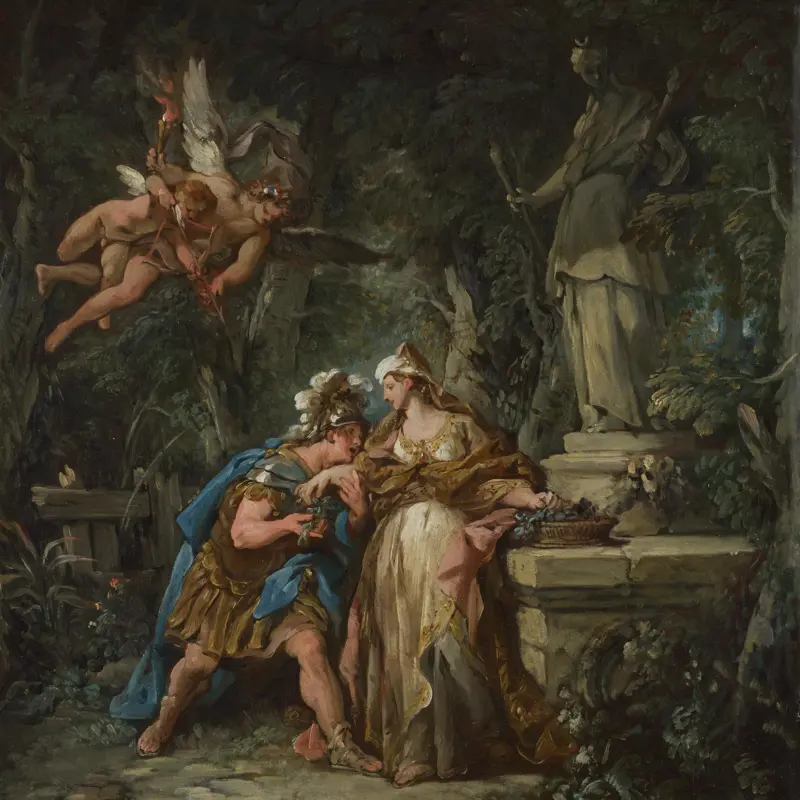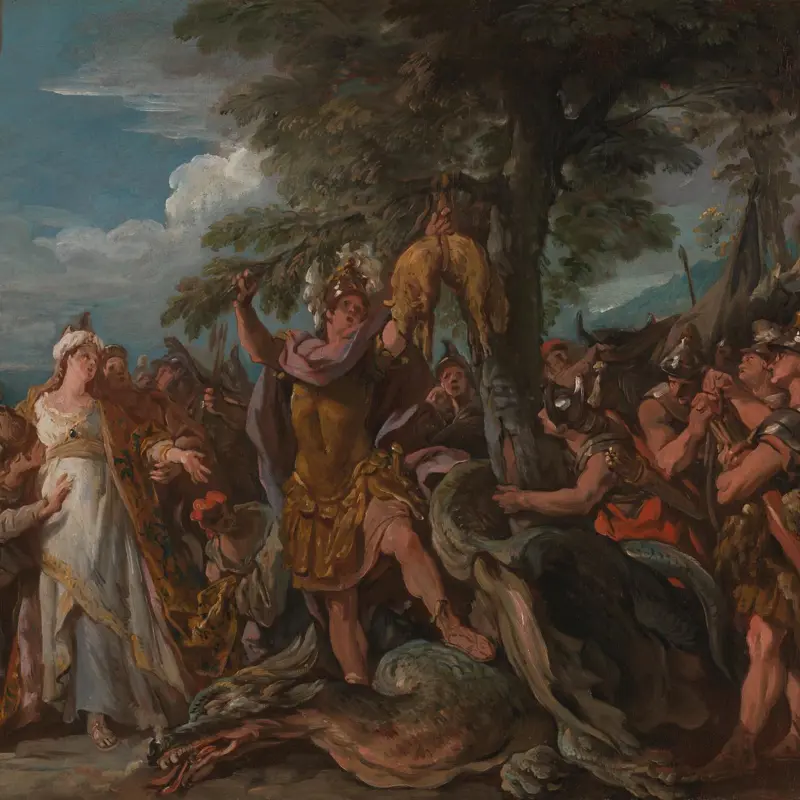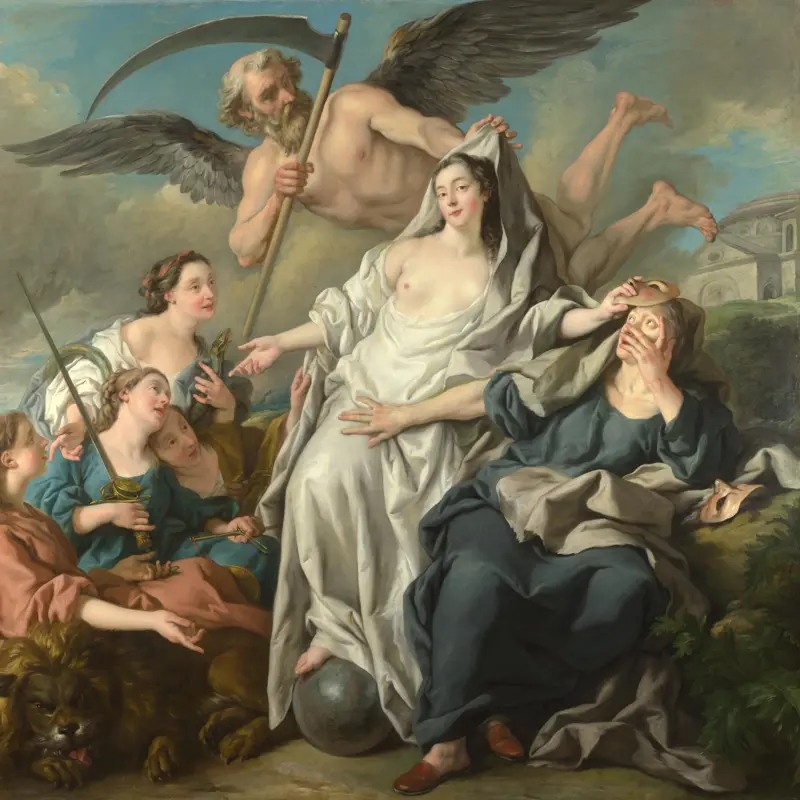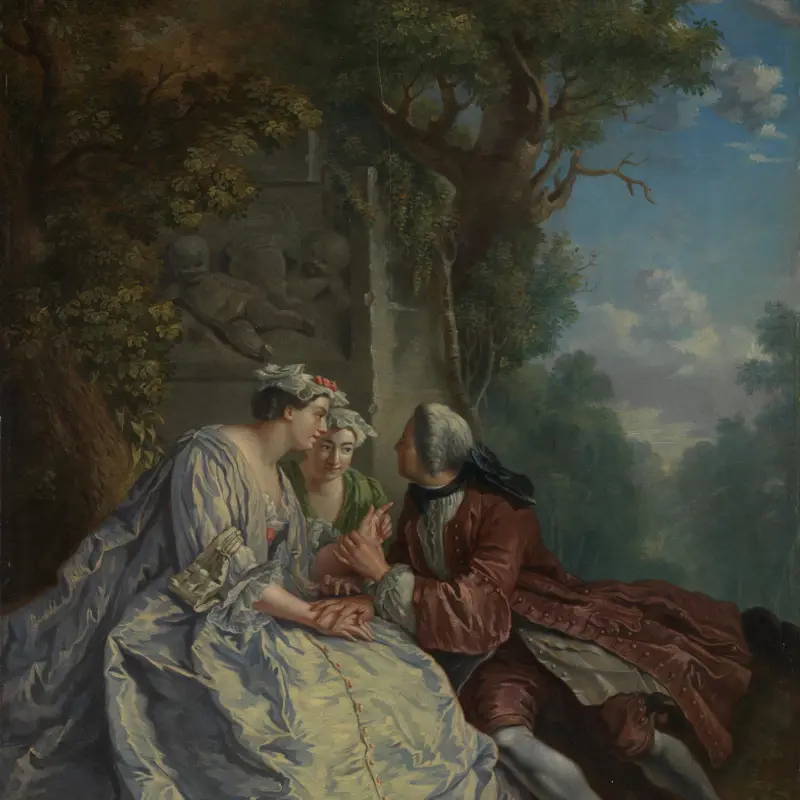Jean-François de Troy, 'The Capture of the Golden Fleece', 1742-3
About the work
Overview
This is the third of a series of seven illustrations of the story of Jason made as sketches for cartoons for the Gobelins tapestry works in Paris. The Gallery also owns the first sketch from the series: Jason swearing Eternal Affection to Medea.
Jason has set out to capture the Golden Fleece, and has used the sorceress Medea’s magic to put to sleep the dragon guarding it. Medea looks up at the Fleece and gestures in wonder towards Jason and the slumbering dragon. Some of the Jason’s shipmates admiringly watch him pull down the Fleece, while others load the Argo ready for the triumphant departure of Jason and Medea.
De Troy made several changes between his sketch of this scene and its related cartoon (Musée d'art Roger-Quilliot, Clermont-Ferrand), perhaps reflecting alterations requested by Philibert Orry, who had commissioned the tapestry series on behalf of the French king.
Key facts
Details
- Full title
- The Capture of the Golden Fleece
- Artist
- Jean-François de Troy
- Artist dates
- 1679 - 1752
- Part of the series
- Sketches for the Story of Jason
- Date made
- 1742-3
- Medium and support
- Oil on canvas
- Dimensions
- 55.6 × 81 cm
- Acquisition credit
- Presented by Mr and Mrs Eliot Hodgkin through the Art Fund, 1987
- Inventory number
- NG6512
- Location
- Not on display
- Collection
- Main Collection
- Frame
- 18th-century French Frame
Provenance
Additional information
Text extracted from the ‘Provenance’ section of the catalogue entry in Humphrey Wine, ‘National Gallery Catalogues: The Eighteenth Century French Paintings’, London 2018; for further information, see the full catalogue entry.
Bibliography
-
1748Anon, Observations sur les arts, et sur quelques morceaux de peinture et de sculpture, exposés au Louvre en 1748, Paris 1748
-
1748L.G. Baillet de St. Julien, Reflexions sur quelques circonstances presentes. contenant deux lettres sur l'exposition des tableaux au Louvre cette année 1748 a M. le comte de R***, Paris 1748
-
1749Anon, Lettre sur la peinture, la sculpture et l'architecture, A M*** Seconde édition… & de réflexions sur les tableaux de M. de Troy, Amsterdam 1749
-
1776L.A. de Bonafons and abbé de Fontenai, Dictionnaire des artistes, Paris 1776
-
1853P.J. Mariette, Abecedario de P.J. Mariette et autres notes inédites de cet amateur sur les arts et les artistes […] annoté par MM. Ph. de Chennevières et A. de Montaiglon, vol. 2, eds P. de Chennevières and A. de Montaiglon, Paris 1853
-
1854Chevalier de Valory, 'Vie de Jean-François Detroy', in Mémoires inédits sur la vie et les ouvrages des membres de l'Académie royale de peinture et de sculpture, Paris 1854, vol. 2
-
1856G.H. Lewes, The Life and Works of Goethe, Boston 1856
-
1900F. Engerand, Inventaire des tableaux commandés et achetés par la direction des bâtiments du roi, 1702-92, Paris 1900
-
1907M. Fenaille, État général des tapisseries de la manufacture des Gobelins, vol. 4, Paris 1907
-
1909P.M. Turner and C.H.C. Baker, Stories of French Artists, London 1909
-
1916C. Phillips, 'Jean-François de Troy', The Burlington Magazine, XXIX/162, 1916, pp. 231-41
-
1930L. Dimier, Les Peintres français du XVIIIe siècle, Paris 1930
-
1934Galerie Cailleux, Exposition esquisses maquettes: Projets et ébauches de l'école française du XVIIIe siècle: Peintures et sculptures au profit de la Société des Amis de l'Enfance (exh. cat., Galerie Cailleux, 12 March 1934 -14 March 1934), Paris 1934
-
1952Hazlitt Gallery, Vasari to Tiepolo: An Exhibition of Fourteen Paintings, London 1952
-
1961B. Nicolson, 'Review of Hazlitt Gallery Exhibition', The Burlington Magazine, CIII, 1961
-
1964J. Thuillier and A. Châtelet, French Painting from Le Nain to Fragonard, Geneva 1964
-
1965E. Young, 'Some Pellegrini Sketches and Their Chronology', Apollo, LXXXII/42, 1965, pp. 104-11
-
1978J. Locquin, La peinture d'histoire en France de 1747 à 1785, Paris 1978
-
1980Paris, Bibliothèque Nationale, Collection Deloynes: Collection de Pièces sur les Beaux-Arts (1673-1808), dite Collection Deloynes, 1980
-
1987National Gallery, 'Pictures Cleaned and Restored in the Conservation Department of the National Gallery, January 1986 - December 1986', National Gallery Technical Bulletin, XI, 1987
-
1988National Gallery, The National Gallery Report: January 1985 - December 1987, London 1988
-
1993M. Levey, Painting and Sculpture in France 1700-1789, New Haven 1993
-
2001
C. Baker and T. Henry, The National Gallery: Complete Illustrated Catalogue, London 2001
-
2002C. Leribault, Jean-François de Troy (1679-1752), Paris 2002
-
2018Wine, Humphrey, National Gallery Catalogues: The Eighteenth Century French Paintings, London 2018
About this record
If you know more about this work or have spotted an error, please contact us. Please note that exhibition histories are listed from 2009 onwards. Bibliographies may not be complete; more comprehensive information is available in the National Gallery Library.
Images
About the series: Sketches for the Story of Jason
Overview
Jason swearing Eternal Affection to Medea and The Capture of the Golden Fleece are two of a series of seven illustrations of the story of Jason. Based on episodes in the Roman poet Ovid’s Metamorphoses, they were made as sketches for cartoons for the Gobelins tapestry works in Paris.
The illustrations were commissioned on behalf of the king of France in 1742. The sketches were finished by 15 February 1743 and the full-size painted cartoons were completed by the end of August 1746. They arrived in Paris in September 1748 and weaving began at the Gobelins works the following year. No less than eight complete sets of tapestries were made, including one which was hung in the king’s room and throne room in the palace of Versailles. Another of the tapestry sets is now in the Victoria and Albert Museum, London.

